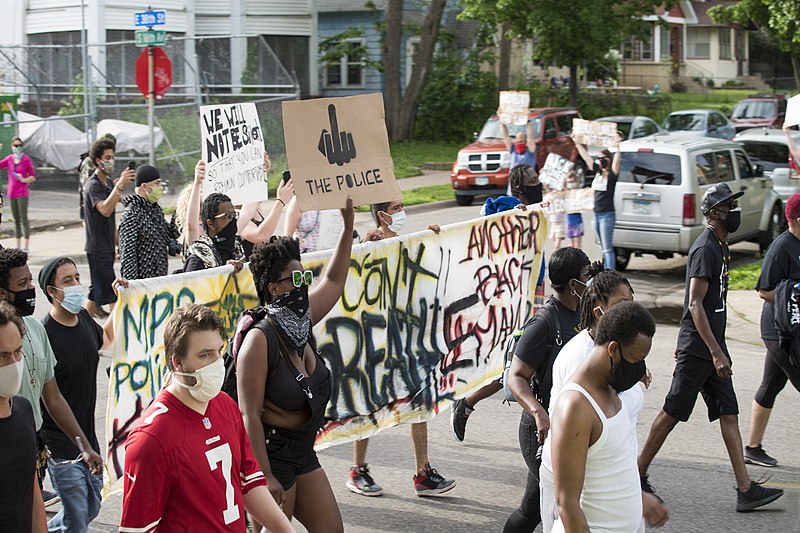Photo by Fibonacci Blue, Minnesota, from https://commons.wikimedia.org/
By Taylor Helmes, Managing Editor
Cities across Southern California saw their share of protests that roiled the nation and world this weekend, sparked by the May 25 death of George Floyd, an unarmed Black man who died while detained by four Minneapolis police officers, one of whom has since been charged with third-degree murder.
While the majority of protesters were peaceful and legal, things escalated in Long Beach, Santa Monica, and other parts of Los Angeles, with looting, property damage, and arrests. Curfews were instituted across the region and Los Angeles Mayor Eric Garcetti, after declaring a state of emergency Saturday, called in the National Guard for support in Los Angeles and Long Beach.
The situation remains volatile today, and curfews have been extended for tonight at 6 p.m. throughout Los Angeles County.
Both CSUDH President Thomas A. Parham and California State University Chancellor Timothy White released statements regarding the situation. Parham’s Friday email announcement emphasized solidarity with the peaceful protesters, but that violence and destruction, “was not the answer.” Parham also included information and virtual resources that students, staff, faculty can take advantage of including our Health and Psychological Resources and Affinity Centers.
Chancellor White’s announcement, dated May 31st and signed by five CSU vice-chancellors as well as White, recognized that it had been a challenging and historic week, but said he hopes that the CSU system could be a “beacon for the world through these heart-wrenchingly difficult times.”
“Never in our lifetimes has there been a sense of helplessness so profound, felt by so many,” White said in the letter. “Feelings of helplessness, unabated, turn to frustration, and frustration to outrage. Outrage is justified and protest – that which leads to action – is imperative, and has been a powerful force for positive change throughout our country’s history. But that same history and our common morality tell us that responding in kind – with violence and destruction – is not the answer and serves only to widen the rifts that divide us.”
Among the message of support and unrest with recent events, White confirmed the idea of an uncertain fall classroom environment in the fall. “Whether virtual or face-to-face… [CSU] will be [a source] of knowledge, tolerance and understanding… We will search for solutions. We will take deeper action that promotes justice in its full breadth including racial, economic, health and social domains. We will explore, discover and express our shared humanity.
“As America’s largest and most vibrantly diverse institution of higher learning, the California State University is and will continue to be a beacon for the world through these heart-wrenchingly difficult times, transforming the feelings of helplessness for many into hopefulness for all.”
Parham expressed his thoughts on recent, “unchecked assaults and traumatic violence aimed at Black, Brown, and poor people,” via email to the CSUDH community on May 29, emphasizing that the diversity on our campus includes those who seek social justice.
“I understand this impulse completely,” Parham said. “Yet, when legitimate forms of freedom of speech, demonstration, protest, and social advocacy deteriorate into the rioting and looting of stores and businesses that people depend on for their daily sustenance, such behaviors must be guarded and guided by the higher principles that instigated our outrage in the first place.”
Parham alluded to the roots of the university, which was moved from Palos Verdes to present-day Carson by Governor Pat Brown after the Watts Rebellion in 1965. “The social justice roots that this university was founded on run deep in our campus DNA,” Parham said.
“Yet, if we become passive spectators to our history, instead of active participants in actualizing the full promise and possibility of our educational mission to challenge biases and assumptions, confront bigotry and prejudice, eradicate cultural ignorance, and help students, staff, and faculty realize a greater measure of our common humanity, then we have not completely fulfilled the legacy we have been blessed to inherit.
“Let us commit to use this tragedy as the impetus to become better versions of ourselves, and find a way as a Toro Nation to impact this country and a world that is sorely in need of transformation.”.
Parham then shared information for students, faculty and staff who might need “to talk, listen to others, reason, shout, or just try to make sense out of this poignant .”
“For students, our dedicated team of Student Health and Psychological Services professionals are available to assist you and may be contacted at (310) 243-3818.
In addition, our student affinity groups are open virtually, including the Rose Black Resource Center, Multicultural Affairs, Women’s Resource Center, EOP Center, and Queer Culture and Resource Center.
Additional psychological resources for students, faculty, and staff can be found on the SHPS Psychological Services web page. Faculty and staff can receive assistance through LifeMatters. They can be reached at (800) 367-7474, and are available 24 hours a day for immediate, in-person access. https://members2.mylifematters.com/portal/welcome/ssoto services. LifeMatters can also be contacted online through the CSUDH LifeMatters portal, password: DHtoros.

